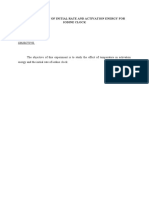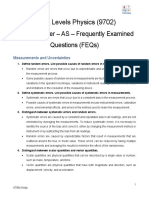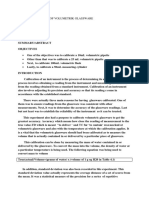Measure and Error Analysis Lab 1
Uploaded by
RexRuMeasure and Error Analysis Lab 1
Uploaded by
RexRuMeasurements & Error Analysis
(Includes Pre Lab Assignment)
Objective
To learn the skill of performing careful measurements, understanding the nature of errors that occur during
measurements, keep track of significant figures, use some basic data analysis techniques, plot graphs and estimate
best fit lines through data points. This will be a collaborative experiment to measure the density of the given
bjects and identify the material. o
Apparatus
Two metal cylinders each, Vernier calipers, mass balance, computer with Data Studio software.
The Skills
D
eveloping some simple laboratory habits
This laboratory experiment is designed to provide you with an appreciation for scientific methodology that includes
setting up experiments, taking and analyzing data, and deriving proper conclusions compatible with a given
theoretical background and hypothesis.
In performing these measurements,
I) You should fill every data column and calculate the answer before moving on to the next column.
II) Let everyone in the group participate in the data taking - distributing the procedure among many people
will reduce random error.
III) Make sure that the result is compatible with your expectation.
IV) Do not put away the experiment before you are sure that the overall conclusion makes sense.
I
ntroduction
Taking data involves measuring something and entering the results in the lab notebook, and possibly in a computer
as well. This something is a physical parameter that can be the length or mass of an object, or simply the time it
takes for a certain event to occur. The measured values are collectively called data. Note that the word data is
lural. p
Data taking is fraught with errors. For example, assume that the width, x, of this paper that you are reading is 12.5
cm (centimeter). To state that x = 12.5 cm leaves the unanswered question, How precise is the result? Could the
width be 12.4 cm or 12.6 cm? No experimental result is ever perfectly precise. For example, it is difficult to read a
meter stick to an accuracy of better than 1 mm (millimeter = 0.1 cm). This is referred to as the resolution error or
sensitivity. Typically, the value of the resolution error is the smallest value that can be read using the instrument.
If we repeat the measurement several times, even with the same meter stick, most likely we will obtain different
esults. For example, after five measurements we might record the following results for the width of the paper: r
x
1
= 12.5 cm, x
2
= 12.4 cm, x
3
= 12.4 cm, x
4
= 12.5 cm, x
5
= 12.3 cm (1)
This is to be expected, since it is impossible to repeat everything exactly the same way and each time we make a
measurement we make a random error. One such source of error is the non-alignment of our eye with the marking
of the meter stick which we are reading, i.e., the eye is not directly over the marking. The best way to reduce
random errors is to average all the measurements. In general, the average value is a more accurate approximation of
he true value than any of the individual measurements. The average width is: t
x
ave
=<x> = (x
1
+ x
2
+ x
3
+ x
4
+ x
5
)/5 = 12.42 cm (2)
But the result in eq. (2) implies that the sensitivity or resolution of our measurement is 0.01 cm or 0.1 mm, which is
certainly not true (the meter stick is marked in mm). Given that our resolution is only 0.1 cm = 1 mm, we should
restrict our result to three significant figures: 12.4 cm (please listen to video module on ilearn). The number of
significant figures tells how many digits of a certain result are actually known. As the meter stick is marked in mm,
our eye can discern only up to the nearest mm. By reporting to 3 significant figures an error of 1 mm is inherent in
the result. Therefore, the final result should be reported as:
x
ave
=<x> = 12.4 0.1 cm
Instructions on use of the Vernier Calipers (Please listen to video module on ilearn)
(a)
Sliding Scale Fixed Scale
Figure 1. (a) Picture of the Vernier calipers that you will use in the lab. (b) A magnified image of the top sliding
scale on the fixed scale. The red arrow points to the alignment at 3.8 on the sliding scale.
The Vernier caliper is an extremely precise measuring instrument; the resolution error is 1/50 mm = 0.02 mm.
To measure an object, close the jaws lightly on the object. Use the longer jaws for measuring outer diameters
and the smaller jaws for measuring inner diameters.
If you are measuring something with a round cross section, make sure that the axis of the object is
perpendicular to the caliper. This is necessary to ensure that you are measuring the full diameter and not merely
a chord.
Use the top scale, which is marked in metric units (ignore the bottom scale, which is calibrated in inches.)
Notice that there is a fixed scale and a sliding scale, as shown in Figure 1.
The boldface numbers on the fixed scale are centimeters.
The tick marks on the fixed scale between the boldface numbers are millimeters.
There are ten major tick marks on the sliding scale. Between each major tick there are 5 small divisions, leading
to a total of 50 small divisions on the sliding scale. The left-most tick mark 0 on the sliding scale will let you
read from the fixed scale the number of whole millimeters that the jaws are opened.
The principle of the Vernier is as follows: When the jaws are closed, the only aligned readings are the 0 on
the sliding scale which is aligned with the 0 on the fixed scale and the 50
th
small division on the sliding scale
is aligned with 49 mm on the fixed scale. Since 50 small divisions on the sliding scale are aligned with 49 mm,
each small division on the sliding scale is short by 1/50 mm = 0.02 mm. Thus the resolution of the Vernier
calipers is 0.02 mm. Next we will understand how to use the Vernier calipers. In terms of the units of the
sliding scale, 10 units correspond to this shortfall of 1mm. So each unit on the sliding scale is short by 1/10 mm
=0.1mm
Step 1 Coarse Reading: Look at the example in Figure 1(b). After inserting an object between the jaws, the 0
mark on the sliding scale is between 21 mm and 22 mm, so the number of whole millimeters is 21.
(b)
2
Step 2 Fine Reading: To measure the extra distance between the 21 mm mark on the fixed scale and the 0 on
the sliding scale, we do the following. We note that 19 small divisions on the sliding scale is in coincidence
with the 4.0 mark on the fixed scale (shown with the red arrow). So the extra distance is 19*0.02 mm = 0.38
mm. A more direct approach is to take the reading 3.8 at the 19
th
division and get the extra distance as [3.8 *
0.1 = 0.38] mm as each unit on the sliding scale corresponds is short by 0.1mm. Note that the resolution of
0.02 mm per division is taken into account in this approach also.
Step 3: Thus the total distance as measured by the Vernier Calipers is the sum of steps 1 and 2. So the caliper
reading is [21.00 mm + (3.8*0.1) =21.38] mm. Note that we keep two significant figures past the decimal given
that the instrument resolution is 0.02 mm.
If two adjacent tick marks on the sliding scale look equally aligned with their counterparts on the fixed scale,
then the reading is half way between the two marks. In the example above, if the 3.8 and 4.0 reading on the
sliding scale looked to be equally aligned with the 4.0 and the 4.1 mark on the fixed scales respectively, then
the reading would be [21.00+(3.9*0.1) = 21.39] mm.
On those rare occasions when the reading just happens to be a "nice" number like 2 cm, don't forget to include
the zero decimal places showing the precision of the measurement and the reading error. So instead of reporting
2 cm, you would report 20.00 mm.
Procedure
In this laboratory, you are going to measure two physical parameters related to cylinders: (1) the size, i.e. diameter
nd height, and (2) the mass. We will then analyze the relationship between these two parameters. a
If D is the diameter and h is the height, then the volume is given by
Volume = Area of base Height = [*(D/2)
2
] h (3)
(Recall that R = D/2, where R is the radius of the base.)
I. Measuring the volume of a set of cylinders [4 points]
1. Diameter: Measure the diameters of the two cylinders at five different places. While you do the measurement,
your partner should record the data. Reverse your roles for the next cylinder. Do not forget to write the units (in
this case mm). Use the vernier calipers to make the measurements.
Enter the values for the Diameter in the table below, and paste it in your notebook. Show the complete
calculation with all steps in your notebook for the cylinder you measured.
Table 1. Cylinder Diameter
Measurement (n) Cylinder 1 Cylinder 2
1
2
3
4
5
Average
Random Error
Resolution Error
Total Error
Analysis
Since random errors will cancel themselves out when a large number of measurements is performed, the mean,
which is the average of all the results, is regarded as the best value. The standard deviation (sigma, ) is the
measure of how spread-out your measurements are and it can be used to get the best estimate of the random
error in this average value. If we designate the number of measurements to be n and the value of a particular
measurement as x
i
, where i is the counter that ranges from 1 to n, then the standard deviation :
3
=
(x
ave
x
i
)
2
i=1
n
n 1
mm (4)
Example: Using the measurements given in Equation (1):
=
1
4
(12.42 12.5)
2
+ (12.4212.4)
2
+ (12.42 12.4)
2
+ (12.42 12.5)
2
+ (12.42 12.3)
2
mm
n
x
ran
= The random error in the mean value of x is: mm
The total error including the resolution error
res
x =0.02 mm and
ran
x is given by:
( ) ( )
2 2
ran res
x x x + = mm
Calculate the total error D for the diameters of the cylinders and write them in the table.
2. Height: Measure the height of the two cylinders at five different places. Decide whether you want to use the
meter stick, scale or Vernier calipers to make the measurement. While you do the measurement, your partner
should record the data. Reverse your roles for the next cylinder. Do not forget to write the units (in this case
cm), and attach the table in your notebook.
Tabulate the measured values similar to Table 1 and calculate the total error h for the heights h of the
cylinders.
3. Volume: From the measured diameter and height, calculate the volume (V) of each cylinder. The volume of
the cylinder is given by: V = [*D
2
]*h/4. When you use the average value of the diameter (D) and height (h)
in your calculation you will get the average value of the volume. Below we show you how to get the error in
the volume leading from the errors D and h from the measurements of the diameter and height respectively.
In general, if one has a quantity W proportional to a
n
* b
m
* c
p
, where a, b, and c are variables, then the
fractional error in W leading from the errors a, b and c from the measurement of a, b, and c is given by:
2 2 2
c
c p
b
b m
a
a n
W
W
(5)
For the particular case of the volume, W corresponds to the average volume V, and W corresponds to the error in
the volume V. The quantities a corresponds to the diameter with n=2, b corresponds to height with m=1. Also
p=c=1 and c=0. Note that in case of formulas with division the exponents n, m, p might have negative values.
Also note that constants do not have errors.
Table 2. Calculation of Density
Average
Mass
Error in Mass Average
Volume
Error in
Volume
Density Error in
Density
Cylinder 1
Cylinder 2
4. Mass: Use the balance provided to measure the mass of the cylinder in grams (gm). Make sure you Tare the
balance before measuring the mass. This makes sure that the mass of pan (and any dirt on it) is accounted for.
The resolution of the balance is 0.01 gm. This will be resolution error in your mass measurement. Note
that digital instruments (such as this balance or your digital watch) will probably read the same mass every time
you measure. This does not mean they do not have any error but is due to the fact that they are made to read in
4
steps. In this case the step size is 0.01gm, which is the error. In the case of your watch the step size would be a
second, which means that your watch cannot measure time any faster. Record the mass measurements and its
error.
Let your TA know the values of the average mass, error in mass, the average volume and its error for the
ylinder you measured. Please list your name and values on the board for the whole class to use. c
Density: If we divide the mass by the volume we obtain the density, which is a constant for a given material.
Record the measured densities of each cylinder along with its uncertainty in column six of table 2. Calculate the
error in the density for each cylinder using the method given on the previous page.
Using the information given below, compare the density measured to that of known materials and identify your
cylinders. Record the identification in your notebook.
T
hen calculate the relative percent error using the following formula:
Relative percent error =
Calculated _ Density True _ Density
True _ Density
100%
How does your relative percent error compare with that corresponding to the total error you measured for
your cylinder?
Densities of some common materials
Material Density (g/cm
3
)
Iron 7.87
Brass (mixture of
Copper and Zinc)
8.55
Copper 8.96
Silver 10.5
Lead 11.3
Gold 19.3
Aluminum 2.69
Water 1.00
II. Graphical Analysis [3.0 points]
Graphical presentation of data is an important way of communicating your results and interpreting their meaning.
Make the graph using the values of mass and volume that the TA has tabulated for the whole class. In making the
raph put the mass on the y-axis and the volume values on the x-axis g
1. From your Windows desktop, click on the Data Studio program icon
2. Click on Enter Data in the How would you like to use the Data Studio page
3. Enter your x, y data in the Table window
4. From the Graph window, click on the Fit menu and under it Linear Fit
Data Studio note: There is a file of helpful information about Data Studio located on your desktop. Click on the
Data Studio Notes folder and then the Graphing with Data Studio file to access it.
The intent is to find the linear fit that matches the pattern of your set of paired data as closely as possible. Out of
all possible linear fits, the least-squares regression line is the one that has the smallest possible value for the sum of
the squares of the residuals.
Linear:* y = mx + b, no modification, "best fit" straight line determines slope m and y-intercept b.
5. Get slope slope, mean squared error, root mean squared error and r
6. Print out your data, along with the best fit, and paste it in your notebook.
Best-fit Straight-line Parameters
Many times the straight-line (regression line) fit to the data along with numerical values of the slope m and the y-
intercept b are important in determining fundamental experimental parameters.
5
This option displays a number of statistical parameters. Of particular interest is the "slope of the linear regression
line" and its error. In some cases the "vertical" or y-intercept and its error are needed also. These straight-line
parameters are determined directly from the data points themselves.
The "correlation coefficient" of the linear regression line is also calculated from the data If r = + 1 then the data
points all lie on a straight line and the calculated regression line is a perfect fit and there is perfect correlation
between the x and y variables. The negative value of r refers to a negative slope to the line.
A value of r equal to zero means that x and y values are completely uncorrelated and the data points are distributed
at random on the graph.
Since all experimental measurements involve some degree of error in measurement, a perfect correlation coefficient
of 1 is not to be expected even if the correct relationship between the dependent (y) and independent (x) variables is
being plotted to yield a straight line. When you are modifying your data to determine the appropriate relationship
etween the variables, the larger the magnitude of r, the better the straight-line fit to the modified data. b
The percentage error, determined from the best estimate of the slope, m, as discussed above and its error, m,
should be determined whenever possible (percent error = (m /m)x100%). For this week's exercise, be sure to
indicate the percentage error in the slope of the straight-line for the data file you selected, and to report this in your
otebook. n
Verify the slope of line by hand. Pick any two points (x
1
,y
1
) and (x
2
,y
2
). Draw a straight line connecting them.
The slope of this straight is:
Density = Slope =
y
x
=
y
2
y
1
x
2
x
1
(6)
The value of the slope should be the density, as the y axis represents the mass and the x axis represents the volume.
Based on the density measured from the linear fit (using the errors), identify the type of cylinder materials.
se the density table provided. U
Additional points will be awarded for your statement of Purpose[0.5], Conclusion[0.5], and Quiz[1.0]. The quiz
will be on reading Vernier calipers, significant figures and error analysis .
Notes on Errors: Aside from random error and resolution error, there are also other types of errors.
One of them is the systematic error. A systematic error is one that is intrinsic in the experimental setup and always
effects the measurement in the same way. An example is the measurement of lengths using a metal ruler which is
inaccurate because the ruler has expanded due to a temperature change, making all the length measurements lower
than the actual lengths.
And then there are mistakes, which are just those made by the experimenter! These, of course, cannot be quantified.
6
7
Pre lab Assignments [1.0 points]
1. Watch the video clip on Vernier Calipers. This will teach you how to use one and how
to make a reading. There will be a quiz on how to read one when you come to the lab.
2. Watch the video clips on Error Analysis and Significant Figures. There will be quiz
questions on these also.
3. Based on the formula given for error analysis in equation (5) on page 4, calculate the
ratio of the error in the volume to the mean volume (V/V) in terms of the corresponding
errors in the measurement of the diameter (D) and the height (h).
All video clips are posted on ilearn. Credit for watching them is automatically given.
You might also like
- Determination of KC For An Esterification Reaction Report100% (3)Determination of KC For An Esterification Reaction Report5 pages
- The Effects of Surface Area On The Rate of A ReactionNo ratings yetThe Effects of Surface Area On The Rate of A Reaction16 pages
- 9702 Grade Booster-AS-Frequently Examined Questions FEQsNo ratings yet9702 Grade Booster-AS-Frequently Examined Questions FEQs20 pages
- Investigation The Relationship Between Hydrochloric Acid and Sodium Thiosulphate0% (1)Investigation The Relationship Between Hydrochloric Acid and Sodium Thiosulphate9 pages
- PMPH120 - Lab 3 - SHM and Spring Constant - SolutionsNo ratings yetPMPH120 - Lab 3 - SHM and Spring Constant - Solutions11 pages
- 12 Determination of The Order of A Chemical Reaction and Its Activation EnergyNo ratings yet12 Determination of The Order of A Chemical Reaction and Its Activation Energy25 pages
- Title Calibration of Volumetrik GlasswareNo ratings yetTitle Calibration of Volumetrik Glassware3 pages
- Experiment 5: Alcohols and Phenols: Eden Cabana, Niña Dominguez, Philip Gabriel Gimotea Locker No. 21100% (1)Experiment 5: Alcohols and Phenols: Eden Cabana, Niña Dominguez, Philip Gabriel Gimotea Locker No. 217 pages
- CAIE-IGCSE-Physics - Alternative to PracticalNo ratings yetCAIE-IGCSE-Physics - Alternative to Practical6 pages
- Biology IA - Effect of Different Chemicals On The Permeability of Membranes of Beetroot TissueNo ratings yetBiology IA - Effect of Different Chemicals On The Permeability of Membranes of Beetroot Tissue5 pages
- Name: Kartikeya Thadani Reg No.: 19bma0029No ratings yetName: Kartikeya Thadani Reg No.: 19bma00294 pages
- Basic Science Physics Question Bank For First Class TestNo ratings yetBasic Science Physics Question Bank For First Class Test2 pages
- Physics Lab Manual - Class 11 Experiment No. 4No ratings yetPhysics Lab Manual - Class 11 Experiment No. 44 pages
- Experiment No. 1 Objective: Vernier Callipers, A Spherical Body (It Can Be A Pendulum Bob), A Beaker or A CalorimeterNo ratings yetExperiment No. 1 Objective: Vernier Callipers, A Spherical Body (It Can Be A Pendulum Bob), A Beaker or A Calorimeter2 pages
- Measurements and Experimentation: Unit 1 Exercise 1 (A) Objective QuestionsNo ratings yetMeasurements and Experimentation: Unit 1 Exercise 1 (A) Objective Questions49 pages
- Determination of KC For An Esterification Reaction ReportDetermination of KC For An Esterification Reaction Report
- The Effects of Surface Area On The Rate of A ReactionThe Effects of Surface Area On The Rate of A Reaction
- 9702 Grade Booster-AS-Frequently Examined Questions FEQs9702 Grade Booster-AS-Frequently Examined Questions FEQs
- Investigation The Relationship Between Hydrochloric Acid and Sodium ThiosulphateInvestigation The Relationship Between Hydrochloric Acid and Sodium Thiosulphate
- PMPH120 - Lab 3 - SHM and Spring Constant - SolutionsPMPH120 - Lab 3 - SHM and Spring Constant - Solutions
- 12 Determination of The Order of A Chemical Reaction and Its Activation Energy12 Determination of The Order of A Chemical Reaction and Its Activation Energy
- Experiment 5: Alcohols and Phenols: Eden Cabana, Niña Dominguez, Philip Gabriel Gimotea Locker No. 21Experiment 5: Alcohols and Phenols: Eden Cabana, Niña Dominguez, Philip Gabriel Gimotea Locker No. 21
- Biology IA - Effect of Different Chemicals On The Permeability of Membranes of Beetroot TissueBiology IA - Effect of Different Chemicals On The Permeability of Membranes of Beetroot Tissue
- Exam Prep for:: Concepts in Transition Metal ChemistryFrom EverandExam Prep for:: Concepts in Transition Metal Chemistry
- Basic Science Physics Question Bank For First Class TestBasic Science Physics Question Bank For First Class Test
- Experiment No. 1 Objective: Vernier Callipers, A Spherical Body (It Can Be A Pendulum Bob), A Beaker or A CalorimeterExperiment No. 1 Objective: Vernier Callipers, A Spherical Body (It Can Be A Pendulum Bob), A Beaker or A Calorimeter
- Measurements and Experimentation: Unit 1 Exercise 1 (A) Objective QuestionsMeasurements and Experimentation: Unit 1 Exercise 1 (A) Objective Questions

























































































